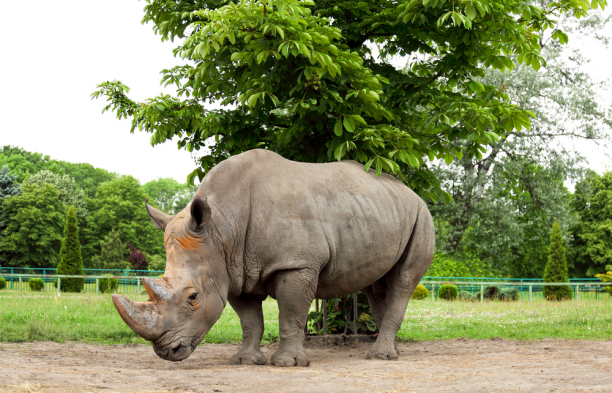
The White Rhinoceros(Ceratotherium simum), also known as the Square-Lipped Rhinoceros lives in Africa. White Rhinos are the largest Rhinoceros species on earth, males, also known as bulls can reach weights up to 3.600 kilograms. The White Rhinoceros name comes from the Afrikaans word “weit” which means wide and refers to the animal’s mouth.
Physical Characteristics
The White Rhinoceros is the largest member of the Rhinocerotidae family, and the largest mammal classified in the Perissodactyla order. The mouth is broad and flat and the upper lip is about 20 centimeters wide. There is a strip of cartilage inside the broad lips that enables it to pick grass as short as 1 inch. The White Rhinoceros has a relatively poor sense of sight, however the senses of hearing and smell are acute, its ears can move independently to pick up more sounds, and its olfactory passages which are responsible for smell are larger than its entire brain. The White Rhinoceros has two horns growing from its snout, the front horn is longer, and can grow to lengths from 40 centimeters to 1.7 meters. The horns continue to grow throughout the White Rhino’s life, but are usually prevented from growing too long by wear, and If one of the horns is broken it will begin to regrow immediately.
| Length | 3.3-4.2 m(10’10”-13’9″) |
| Shoulder Height | 1.7-1.9 m(5’7″-6’3″) |
| Tail Length | 50-70 cm(1’8”-2’4″) |
| Weight | 1,400-3,600 kg(3,087-7, 937 lbs.) |
Habitat and Distribution
White Rhinos inhabit grasslands, savannas, and woodlands in the countries of Botswana, Eswatini, Kenya, Namibia, South Africa, Uganda, and Zimbabwe. White Rhinos live in groups of up to ten individuals. These groups are made up of females, while the dominant bulls live on their own but stay near the females. Each group never wanders from a home range of about 8 square kilometers.
Breeding
Males and females can breed throughout the year. Males often fight to win the right to mate with a female. Courtship rituals include chasing, and vocalizing. After the pair mates, the female will give birth to typically one calf after a gestation period of 16 months. The calf can stand just a few hours after birth but are wobbly for the first 2 to 3 days. The calf will begin eating greens at one week of age, but will still nurse for over 12 months. Young White Rhinos stay with their mothers for two to three years, leaving only when the mother chases them off before giving birth to the next calf. The female reaches sexual maturity between 6 to 7 years of age and males reach sexual maturity between 10 to 12 years of age.
Diet
White Rhinos are grazing herbivores that only eat grass. They use their short legs, long head, and wide mouth along with a side to side head movement to eat huge amounts of grass. They drink water about twice a day, but if water is scarce they can survive up to five days without drinking.
Fun Facts
- White Rhinos can live up to 50 years.
- the Ol Pejeta Conservancy in Laikipia, Kenya is home to some White Rhinos.
- White Rhinos can gallop for short bursts at 40km/hr, and can also maintain a pace of 24km/hr for at least five km.
- White Rhinos spend about half of the day eating.
- The White Rhinoceros has been depicted on the South African ten Rand note.
